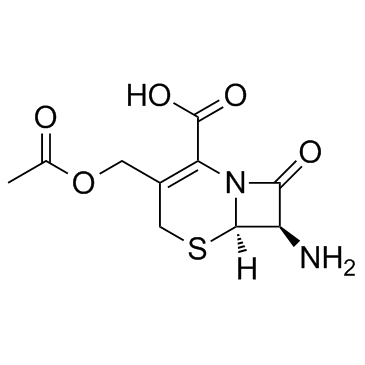58-71-9
| Name | cephalothin sodium |
|---|---|
| Synonyms |
sodium (6R,7R)-3-[(acetyloxy)methyl]-8-oxo-7-[(thiophen-2-ylacetyl)amino]-5-thia-1-azabicyclo[4.2.0]oct-2-ene-2-carboxylate
5-Thia-1-azabicyclo[4.2.0]oct-2-ene-2-carboxylic acid, 3-[(acetyloxy)methyl]-8-oxo-7-[[2-(2-thienyl)acetyl]amino]-, sodium salt, (6R,7R)- (1:1) Sodium (6R,7R)-3-(acetoxymethyl)-8-oxo-7-[(2-thienylacetyl)amino]-5-thia-1-azabicyclo[4.2.0]oct-2-ene-2-carboxylate Cephalothin Sodium Cephalothin EINECS 200-394-6 MFCD00072025 Cephalothin sodium salt Cephalothin (sodium) |
| Description | Cephalothin sodium is a first generation cephem antibiotic with a wide range antibacterial activity, is active against gram-positive and gram-negative bacteria. |
|---|---|
| Related Catalog |
| Boiling Point | 757.2ºC at 760 mmHg |
|---|---|
| Melting Point | 240°C |
| Molecular Formula | C16H15N2NaO6S2 |
| Molecular Weight | 418.420 |
| Flash Point | 411.8ºC |
| Exact Mass | 418.026917 |
| PSA | 169.38000 |
| Water Solubility | 158 mg/L |
|
Material Safety Data Sheet
Section1. Identification of the substance Product Name: Cefalotin sodium salt Synonyms: Section2. Hazards identification Harmful by inhalation, in contact with skin, and if swallowed. H334:May cause allergy or asthma symptoms or breathing difficulties if inhaled
H317:May cause an allergic skin reaction P285:In case of inadequate ventilation wear respiratory protection P280:Wear protective gloves/protective clothing/eye protection/face protection P342+P311:If experiencing respiratory symptoms: Call a POISON CENTER or doctor/physician P363:Wash contaminated clothing before reuse P304+P341:IF INHALED: If breathing is difficult, remove victim to fresh air and keep at rest in a position comfortable for breathing Section3. Composition/information on ingredients. Ingredient name:Cefalotin sodium salt CAS number:58-71-9 Section4. First aid measures Skin contact:Immediately wash skin with copious amounts of water for at least 15 minutes while removing contaminated clothing and shoes. If irritation persists, seek medical attention. Eye contact:Immediately wash skin with copious amounts of water for at least 15 minutes. Assure adequate flushing of the eyes by separating the eyelids with fingers. If irritation persists, seek medical attention. Inhalation:Remove to fresh air. In severe cases or if symptoms persist, seek medical attention. Ingestion:Wash out mouth with copious amounts of water for at least 15 minutes. Seek medical attention. Section5. Fire fighting measures In the event of a fire involving this material, alone or in combination with other materials, use dry powder or carbon dioxide extinguishers. Protective clothing and self-contained breathing apparatus should be worn. Section6. Accidental release measures Personal precautions: Wear suitable personal protective equipment which performs satisfactorily and meets local/state/national standards. Respiratory precaution:Wear approved mask/respirator Hand precaution:Wear suitable gloves/gauntlets Skin protection:Wear suitable protective clothing Eye protection:Wear suitable eye protection Methods for cleaning up: Mix with sand or similar inert absorbent material, sweep up and keep in a tightly closed container for disposal. See section 12. Environmental precautions: Do not allow material to enter drains or water courses. Section7. Handling and storage Handling:This product should be handled only by, or under the close supervision of, those properly qualified in the handling and use of potentially hazardous chemicals, who should take into account the fire, health and chemical hazard data given on this sheet. Storage:Store in closed vessels. Section8. Exposure Controls / Personal protection Engineering Controls: Use only in a chemical fume hood. Personal protective equipment: Wear laboratory clothing, chemical-resistant gloves and safety goggles. General hydiene measures: Wash thoroughly after handling. Wash contaminated clothing before reuse. Section9. Physical and chemical properties Not specified Appearance: Boiling point:No data Melting point:No data Flash point:No data Density:No data Molecular formula:C16H15N2O6S2.Na Molecular weight:418.4 Section10. Stability and reactivity Conditions to avoid: Heat, flames and sparks. Materials to avoid: Oxidizing agents. Possible hazardous combustion products: Carbon monoxide, nitrogen oxides, sulfur oxides. Section11. Toxicological information No data. Section12. Ecological information No data. Section13. Disposal consideration Arrange disposal as special waste, by licensed disposal company, in consultation with local waste disposal authority, in accordance with national and regional regulations. Section14. Transportation information Non-harzardous for air and ground transportation. Section15. Regulatory information No chemicals in this material are subject to the reporting requirements of SARA Title III, Section 302, or have known CAS numbers that exceed the threshold reporting levels established by SARA Title III, Section 313. SECTION 16 - ADDITIONAL INFORMATION N/A |
CHEMICAL IDENTIFICATION
HEALTH HAZARD DATAACUTE TOXICITY DATA
|
| Symbol |

GHS08 |
|---|---|
| Signal Word | Danger |
| Hazard Statements | H317-H334 |
| Precautionary Statements | P261-P280-P284-P304 + P340-P342 + P311 |
| Personal Protective Equipment | dust mask type N95 (US);Eyeshields;Faceshields;Gloves |
| Hazard Codes | Xn: Harmful; |
| Risk Phrases | R42/43 |
| Safety Phrases | S22-S36/37 |
| RIDADR | NONH for all modes of transport |
| WGK Germany | 2 |
| RTECS | XI0388300 |
| HS Code | 3003201900 |
|
~26% 
58-71-9 |
| Literature: Cowley; Humber; Laundon; et al. Tetrahedron, 1983 , vol. 39, # 3 p. 461 - 467 |
|
~% 
58-71-9 |
| Literature: Journal of the Chemical Society, Perkin Transactions 2: Physical Organic Chemistry (1972-1999), , p. 1815 - 1822 |
| Precursor 3 | |
|---|---|
| DownStream 0 | |
| HS Code | 3003201900 |
|---|



